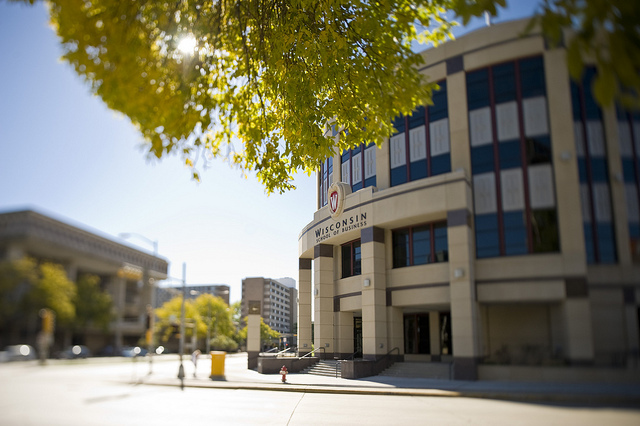Cliffhangers inspire sustainability at School of Business

The sustainability effort used Grainger Hall as a marketing laboratory to encourage energy savings.
While Earth Day is an opportunity to encourage people to think more about the environment, a new marketing professor at the Wisconsin School of Business is taking an innovative approach to sustainability.

Evan Polman
Evan Polman, who started in the fall of 2013 as an assistant professor, has taken the idea of cliffhangers, and how they keep us coming back for more on TV shows like “Breaking Bad” and “Scandal,” to reduce energy use.
Polman led a class experiment to determine which messages convince people to make environmentally friendly choices.
The idea came about when Polman was facilitating a discussion with a group of students in his marketing strategy undergraduate course. They were talking about how to use psychology to change human behavior for the better.
The group started talking about the placards hotels started using a few years ago to encourage the reuse of towels and sheets. What if, a student asked, we had similar signs in Grainger Hall that encouraged people to take the stairs? As the group continued to brainstorm, the idea was born.
“We had a really good discussion, and one student said ‘what if it was a joke?’ For example, there could be a placard with a joke, and then it would say go to the stairs to find the punch line,” Polman says. “I thought that was a really cool way of steering people toward the stairs. It’s not unlike ‘Breaking Bad’s’ cliffhangers. They get you so anxious that you immediately want to see the next episode.”
Eventually settling on trivia questions rather than jokes, the students put together the experiment and called the project, Badger Banter. For example, one trivia question asked, “What animals preceded man into space?” The answers – frog, guinea pig, rabbit and fruit fly – could all be found on different flights of stairs.
“This project encouraged students to think creatively, apply concepts from class, and — as marketers — to find ways to guide people’s choices. Even better than addressing one problem, our intervention has the potential to solve two problems at once: saving energy by not taking the elevator and encouraging fitness by taking the stairs.”
Evan Polman
The group worked with Grainger Hall building services to install a battery-powered sensor that counted the number of people who climbed the stairs on any given day. After establishing a baseline number for nine days, the group conducted the experiment, working with building services to change the trivia question and answers every day for 23 days.
When the data came back, Polman, along with colleague and associate professor of marketing Joann Peck, was pleasantly surprised. (Polman and Peck are working on an academic paper about the project). The data showed that foot traffic increased on the stairs by 8.3 percent, a significant jump compared to many other common sustainability or fitness interventions, Polman says.
Few people disagree about the importance of reducing energy use, food waste, or litter. The challenge, as Polman describes it, is motivation. How do you make the behavioral change easy and create the warm fuzzy feelings of helping the environment or getting into shape?
“A big part of these interventions is making them easy to use,” Polman said. “The Badger Banter signs prompted people to take the stairs, and in this case, it’s not that inconvenient. You’re right next to the elevator.”
Marketing and international business major Angela Davis was a part of the marketing strategy class, and said the experiment, along with other course projects, sparked her interest in consumer behavior. This semester, she is working with Polman on an independent study project.
“I think the class has helped me think differently and outside of the box,” Davis says. “To not just think of how to answer questions normally, but to look at questions from different angles and apply some non-marketing concepts to understand the consumer better.”
Davis also administered a poll for faculty and students after the experiment. Of the respondents who saw the signs, 84 percent said they wanted to know the answers to the trivia questions, which suggests to Polman that the chosen questions tugged on the human need for closure.
Polman said he would like to run the experiment again, testing a different method of encouraging healthy or environmentally friendly behavior.
“I like to think of Grainger Hall as a lab, this experimental place where students can try out and test the efficacy of their ideas,” Polman says. “This project encouraged students to think creatively, apply concepts from class, and — as marketers — to find ways to guide people’s choices. Even better than addressing one problem, our intervention has the potential to solve two problems at once: saving energy by not taking the elevator and encouraging fitness by taking the stairs.”




